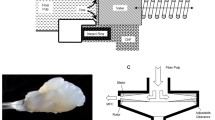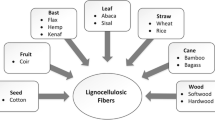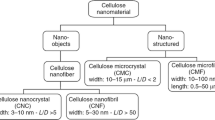Abstract
Purpose of Review
The potential of nanotechnology and nanocomposites in various sectors of research and application is promising and attracting increasing investment. The purpose of this paper is to provide a review of the preparation of nanomaterials from different cellulosic sources including wood. The transformation of cellulose down to the nanoscale endow these nanomaterials with new properties that give cellulose many new industrial applications in different fields, and an overview of the sound markets that can be impacted by cellulose nanomaterials is provided.
Recent Findings
Unexpected and attractive properties can be observed when decreasing the size of a material down to the nanoscale. Cellulose is no exception to the rule. Cellulose nanomaterials exhibit specific outstanding properties and are potentially useful for a large number of industrial applications. Now, after intensive research, several initiatives have emerged in the perspective of producing cellulose nanomaterials at large scale. A number of organizations have announced cellulose nanomaterial demonstration plants.
Summary
Despite being the most available natural polymer on earth, it is only quite recently that cellulose has gained prominence as a nanostructured material. Different forms of cellulose nanomaterials, resulting from a top-down deconstructing strategy (cellulose nanocrystals-CNCs, cellulose nanofibrils-CNFs) or bottom-up strategy (bacterial cellulose-BC) can be prepared. Multiple mechanical shearing actions applied to cellulosic fibers release more or less individually the nanofibrils. A controlled strong acid hydrolysis treatment can be applied to cellulosic fibers allowing dissolution of amorphous domains. The mechanical modulus of crystalline cellulose is the basis of many potential applications.





Similar content being viewed by others
References
Papers of particular interest, published recently, have been highlighted as: • Of importance •• Of major importance
•• Dufresne A. Nanocellulose: from nature to high performance tailored materials. 2nd ed. Berlin/Boston: Walter de Gruyter GmbH & Co KG; 2017. This specialist monograph provides an overview of the recent research on the fundamental and applied properties of nanoparticles extracted from cellulose. This revised and updated second edition expands the broad overview of recent research.
Nickerson RF, Habrle JA. Cellulose intercrystalline structure. Ind Eng Chem. 1947;39:1507–12.
Herrick FW, Casebier RL, Hamilton JK, Sandberg KR. Microfibrillated cellulose: morphology and accessibility. J Appl Polym Sci Polym Symp. 1983;37:797–813.
Turbak AF, Snyder FW, Sandberg KR. microfibrillated cellulose: a new cellulose product: properties, uses, and commercial potential. J Appl Polym Sci Polym Symp. 1983;37:815–27.
Lavoine N, Desloges I, Dufresne A, Bras J. Microfibrillated cellulose - its barrier properties and applications in cellulosic materials: a review. Carbohydr Polym. 2012;90:735–64.
Lin N, Huang J, Dufresne A. Preparations, properties and applications of polysaccharide nanocrystals in advanced functional nanomaterials: a review. Nanoscale. 2012;4:3274–94.
Mariano M, El Kissi N, Dufresne A. Cellulose nanocrystals and related nanocomposites: review of some properties and challenges. J Polym Sci Polym Phys. 2014;52:791–806.
• Kargarzadeh H, Gopakumar D, Mariano M, Ahmad I, Thomas S, Dufresne A, et al. Recent developments on nanocellulose reinforced polymer nanocomposites: a review. Polymer. 2017;132:368–93 This review addresses critical factors in the manufacturing of cellulose nanomaterial composites. It also introduces and comprehensively discusses various processing techniques.
Ferreira FV, Dufresne A, Pinheiro IF, Souza DHS, Gouveia RF, Mei LHI, et al. How do cellulose nanocrystals affect the overall properties of biodegradable polymer nanocomposites: a comprehensive review. Eur Polym J. 2018;108:274–85.
• Kargarzadeh H, Huang J, Lin N, Ahmad I, Mariano M, Dufresne A, et al. Recent developments in nanocellulose-based biodegradable polymers, thermoplastic polymers, and porous nanocomposites. Prog Polym Sci. 2018;87:197–227 This paper presents an overview of recent developments in cellulose nanomaterials, including the production, characterization, properties, and range of applications of cellulose nanomaterial-based biodegradable polymers, thermoplastic polymers, and porous nanocomposites.
Kargarzadeh H, Ahmad I, Abdullah I, Dufresne A, Zainudin SY, Sheltami RM. Effects of hydrolysis conditions on the morphology, crystallinity, and thermal stability of cellulose nanocrystals extracted from kenaf bast fibers. Cellulose. 2012;19:855–66.
Malainine ME, Dufresne A, Dupeyre D, Mahrouz M, Vuong R, Vignon MR. Structure and morphology of cladodes and spines of Opuntia Ficus-Indica. Cellulose extraction and characterization. Carbohydr Polym. 2003;51:77–83.
Varanasi S, He R, Batchelor W. Estimation of cellulose nanofibre aspect ratio from measurements of fibre suspension gel point. Cellulose. 2013;20:1885–96.
Tanaka R, Saito T, Ishii D, Isogai A. Determination of nanocellulose fibril length by shear viscosity measurement. Cellulose. 2014;21:1581–9.
Kangas H, Lahtinen P, Sneck A, Saariaho A-M, Laitinen O, Hellén R. Characterization of fibrillated celluloses. A short review and evaluation of characteristics with a combination of methods. Nord Pulp Pap Res J. 2014;29:129–43.
Desmaisons J, Boutonnet E, Rueff M, Dufresne A, Bras J. A new quality index for benchmarking of different cellulose nanofibrils. Carbohydr Polym. 2017;174:318–29.
Flauzino Neto WP, Mariano M, Vieira da Silva IS, Silvério HA, Putaux JL, Otaguro H, et al. Mechanical properties of natural rubber nanocomposites reinforced with high aspect ratio cellulose nanocrystals isolated from soy hulls. Carbohydr Polym. 2016;153:143–52.
Doris GM, Ben Y, Hu T-Q, Neault P. Dry cellulose filaments and the method of making the same. 2014; WO 2014/071523 Al.
Siqueira G, Abdillahi H, Bras J, Dufresne A. High reinforcing capability cellulose nanocrystals extracted from Syngonanthus nitens (Capim Dourado). Cellulose. 2010;17:289–98.
Filson PB, Dawson-Andoh BE, Schwegler-Berry D. Enzymatic-mediated production of cellulose nanocrystals from recycled pulp. Green Chem. 2009;11:1808–14.
Hirota M, Tamura N, Saito T, Isogai A. Water dispersion of cellulose II nanocrystals prepared by TEMPO-mediated oxidation of mercerized cellulose at pH 4.8. Cellulose. 2010;17:279–88.
Kontturi E. Process for preparing micro- and nanocrystalline cellulose. Patent WO2011/114005; 2011.
Man Z, Muhammad N, Sarwono A, Bustam MA, Kumar MV, Rafiq S. Preparation of cellulose nanocrystals using an ionic liquid. J Polym Environ. 2011;19:726–31.
Leung ACW, Hrapovic S, Lam E, Liu Y, Male KB, Mahmoud KA, et al. Characteristics and properties of carboxylated cellulose nanocrystals prepared from a novel one-step procedure. Small. 2011;7:302–5.
Yang H, Alam MDN, van de Ven TGM. Highly charged nanocrystalline cellulose and dicarboxylated cellulose from periodate and chlorite oxidized cellulose fibers. Cellulose. 2013;20:1865–75.
Lu Q, Tang L, Lin F, Wang S, Chen Y, Chen X, et al. Preparation and characterization of cellulose nanocrystals via ultrasonication-assisted FeCl3-catalyzed hydrolysis. Cellulose. 2014;21:3497–506.
Novo LP, Bras J, García A, Belgacem N, Curvelo AAS. Subcritical water: a method for green production of cellulose nanocrystals. ACS Sustain Chem Eng. 2015;3:2839–46.
Kunaver M, Anžlovar A, Žagar E. The fast and effective isolation of nanocellulose from selected cellulosic feedstocks. Carbohydr Polym. 2016;148:251–8.
Sirviö JA, Visanko M, Liimatainen H. Acidic deep eutectic solvents as hydrolytic media for cellulose nanocrystals production. Biomacromolecules. 2016;17:3025–32.
Siqueira G, Bras J, Dufresne A. New process of chemical grafting of cellulose nanoparticles with a long chain isocyanate. Langmuir. 2010;26:402–11.
Bras J, Viet D, Bruzzese C, Dufresne A. Correlation between stiffness of sheets prepared from cellulose whiskers and nanoparticles dimensions. Carbohydr Polym. 2011;84:211–5.
Dufresne A. Cellulose nanomaterial reinforced polymer nanocomposites. Curr Opin Colloid Interface Sci. 2017;29:1–8.
Mariano M, El Kissi N, Dufresne A. Cellulose nanomaterials: size and surface influence on the thermal and rheological behavior. Polimeros. 2018;28:93–102.
Espino-Pérez E, Bras J, Ducruet V, Guinault A, Dufresne A, Domenek S. Influence of chemical surface modification of cellulose nanowhiskers on thermal, mechanical, and barrier properties of poly (lactide) based bionanocomposites. Eur Polym J. 2013;49:3144–54.
Österberg M, Vartiainen J, Lucenius J, Hippi U, Seppälä J, Serimaa R, et al. A fast method to produce strong NFC films as a platform for barrier and functional materials. ACS Appl Mater Interfaces. 2013;5:4640–7.
Benhamou K, Dufresne A, Magnin A, Mortha G, Kaddami H. Control of size and viscoelastic properties of nanofibrillated cellulosefrom palm tree by varying the TEMPO-mediated oxidation time. Carbohydr Polym. 2014;99:74–83.
Dufresne A. Nanocellulose: a new ageless bionanomaterial. Mater Today. 2013;16:220–7.
Sheltami RM, Kargarzadeh H, Abdullah I, Ahmad I. Thermal properties of cellulose nanocomposites. In Handbook of nanocellulose and cellulose nanocomposites, Vol. 1. Ed. Kargarzadeh H, Ahmad I, Thomas S, Dufresne A. Weinheim: Wiley-VCH Verlag GmbH & Co. KGaA; 2017 :523–52.
Lin N, Dufresne A. Surface chemistry, morphological analysis and properties of cellulose nanocrystals with gradiented sulfation degrees. Nanoscale. 2014;6:5384–93.
Nogi M, Iwamoto S, Nakagaito AN, Yano H. Optically transparent nanofiber paper. Adv Mater. 2009;21:1595–8.
• Gray DG. Order and gelation of cellulose nanocrystal suspensions: an overview of some issues. Phil Trans R Soc A. 2018;376:20170041 Some insight into the processes that govern the formation of solid chiral nematic films from CNC suspensions is provided.
Wang P-X, MacLachlan MJ. Liquid crystalline tactoids: ordered structure, defective coalescence and evolution in confined geometries. Phil Trans R Soc A. 2018;376:20170042.
Wang J, Gardner DJ, Stark NM, Bousfield DW, Tajvidi M, Cai Z. Moisture and oxygen barrier properties of cellulose nanomaterial-based films. ACS Sustain Chem Eng. 2018;6:49–70.
Roman M. Toxicity of cellulose nanocrystals: a review. Ind Biotechnol. 2015;11:25–33.
Camarero-Espinosa S, Endes C, Mueller S, Petri-Fink A, Rothen-Rutishauser B, Weder C, et al. Elucidating the potential biological impact of cellulose nanocrystals. Fibers. 2016;4:21.
Favier V, Canova GR, Cavaillé JY, Chanzy H, Dufresne A, Gauthier C. Nanocomposites materials from latex and cellulose whiskers. Polym Adv Technol. 1995;6:351–5.
• Dufresne A. Cellulose nanomaterials as green nanoreinforcements for polymer nanocomposites. Phil Trans R Soc A. 2018;376:20170040 This paper focuses on the processing techniques that can be used to prepare cellulose reinforced polymer nanocomposites, with an emphasis on melt processing that remains a challenge.
Desmaisons J, Gustafsson E, Dufresne A, Bras J. Hybrid nanopaper of cellulose nanofibrils and PET microfibers with high tear and crumpling resistance. Cellulose. 2018;25:7127–42.
Dreyfuss-Deseigne R. La nanocellulose en conservation-restauration: première application de ce nouveau matériau prometteur pour la consolidation des œuvres graphiques à caractère translucide et transparent. Tracé. 2016;16:75–83.
Völkel L, Ahn K, Hähner U, Gindl-Altmutter W, Potthast A. Nano meets the sheet: adhesive-free application of nanocellulosic suspensions in paper conservation. Herit Sci. 2017;5:23.
Vardanyan V, Poaty B, Chauve G, Landry V, Galstian T, Riedl B. Mechanical properties of UV-waterborne varnishes reinforced by cellulose nanocrystals. J Coat Technol Res. 2014;11:841–52.
Kaboorani A, Auclair N, Riedl B, Landry V. Physical and morphological properties of UV-cured cellulose nanocrystal (CNC) based nanocomposite coatings for wood furniture. Prog Org Coat. 2016;93:17–22.
https://www.celluforce.com/en/applications/#anchor26. Accessed 17 Feb 2019.
Hubbe M, Ferrer A, Tyagi P, Yin Y, Salas C, Pal L, et al. Nanocellulose in thin films, coatings, and plies for packaging applications: a review. Bioresources. 2017;12:2143–233.
Li F, Mascheroni E, Piergiovanni L. The potential of nanocellulose in the packaging field: a review. Packag Technol Sci. 2015;28:475–508.
Azeredo HMC, Rosa MF, Mattoso LHC. Nanocellulose in bio-based food packaging applications. Ind Crop Prod. 2017;97:664–71.
Sun L, Chen W, Liu Y, Li J, Yu H. Soy protein isolate/cellulose nanofiber complex gels as fat substitutes: rheological and textural properties and extent of cream imitation. Cellulose. 2015;22:2619–27.
Andrade DR, Mendonça MH, Helm CV, Magalhães WL, de Muniz GI, Kestur SG. Assessment of nano cellulose from peach palm residue as potential food additive: part II: preliminary studies. J Food Sci Technol. 2015;52:5641–50.
Gindl-Altmutter W, Veigel S. Nanocellulose-modified wood adhesives. In: Oksman K, Mathew AP, Qvintus P, Bismarck A, Rojas O, Sain M, editors. Handbook of green materials: processing technologies, properties and applications, vol. 2. Singapore: World Scientific Publishing Co Pte Ltd; 2014. p. chap 17.
Chaindawong C, Johannsmann D. An anisotropic ink based on crystalline nanocellulose: potential applications in security printing. J Appl Polym Sci. 2014;131:41063.
Nechyporchuk O, Yu J, Nierstrasz VA, Bordes R. Cellulose nanofibril-based coatings of woven cotton fabrics for improved inkjet printing with a potential in e-textile manufacturing. ACS Sustain Chem Eng. 2017;5:4793–801.
Abouzeid RE, Khiari R, Beneventi D, Dufresne A. Biomimetic mineralization of three-dimensional printed alginate/TEMPO-oxidized cellulose nanofibril scaffolds for bone tissue engineering. Biomacromolecules. 2018;19:4442–52.
Siqueira G, Kokkinis D, Libanori R, Hausmann MK, Gladman AS, Neels A, et al. Cellulose nanocrystal inks for 3D printing of textured cellular architectures. Adv Funct Mater. 2017;27:1604619.
Fu T, Moon RJ, Zavattieri P, Youngblood J, Weiss WJ. Cellulose nanomaterials as additives for cementitious materials. In Cellulose-reinforced nanofibre composites: production, properties and applications. Jawaid M, Boufi S, Khalil AHPS Eds. 2017:455–482.
Jung YH, Chang T-H, Zhang H, Yao C, Zheng Q, Yang VW, et al. High-performance green flexible electronics based on biodegradable cellulose nanofibril paper. Nat Commun. 2015;6:7170.
Kim D, Ko Y, Kwon G, Kim U-J, You J. Micropatterning silver nanowire networks on cellulose nanopaper for transparent paper electronics. ACS Appl Mater Interfaces. 2018;10:38517–25.
Wang X, Yao C, Wang F, Li Z. Cellulose-based nanomaterials for energy applications. Small. 2017;13:1702240.
Golmohammadi H, Morales-Narváez E, Naghdi T, Merkoçi A. Nanocellulose in sensing and biosensing. Chem Mater. 2017;29:5426–46.
Fujisawa S, Togawa E, Kuroda K. Nanocellulose-stabilized Pickering emulsions and their applications. Sci Technol Adv Mater. 2017;18:959–71.
Abouzeid RE, Khiari R, El-Wakil N, Dufresne A. Current state and new trends in the use of cellulose nanomaterials for wastewater treatment. Biomacromolecules. 2019;20:573–97.
Lin N, Dufresne A. Nanocellulose in biomedicine: current status and future prospect. Eur Polym J. 2014;59:302–25.
https://www.personalcare1.com/articles/new-whitening-cosmetics-applying-nanocellulose-technology. Accessed 12 Feb 2019.
Kevin J, De France KJ, Hoare T, Cranston ED. Review of hydrogels and aerogels containing nanocellulose. Chem Mater. 2017;29:4609–31.
Nascimento DM, Nunes YL, Figueirêdo MCB, de Azeredo HMC, Aouada FA, Feitosa JPA, et al. Nanocellulose nanocomposite hydrogels: technological and environmental issues. Green Chem. 2018;20:2428–48.
Sun X, Zhang Y, Chen G, Gai Z. Application of nanoparticles in enhanced oil recovery: a critical review of recent progress. Energies. 2017;10:345.
Funding
LGP2 is part of the LabEx Tec 21 (Investissements d’Avenir - grant agreement n°ANR-11-LABX-0030) and of PolyNat Carnot Institut (Investissements d’Avenir - grant agreement n°ANR-16-CARN-025-01).
Author information
Authors and Affiliations
Corresponding author
Ethics declarations
Conflict of Interest
Alain Dufresne declares that he has no conflict of interest.
Human and Animal Rights and Informed Consent
This article does not contain any studies with human or animal subjects performed by the author.
Additional information
Publisher’s Note
Springer Nature remains neutral with regard to jurisdictional claims in published maps and institutional affiliations.
This article is part of the Topical Collection on Wood Structure and Function
Rights and permissions
About this article
Cite this article
Dufresne, A. Nanocellulose Processing Properties and Potential Applications. Curr Forestry Rep 5, 76–89 (2019). https://doi.org/10.1007/s40725-019-00088-1
Published:
Issue Date:
DOI: https://doi.org/10.1007/s40725-019-00088-1




